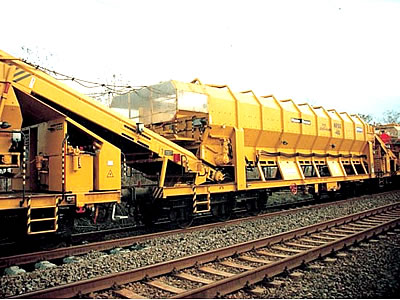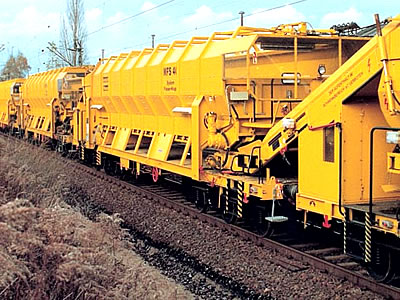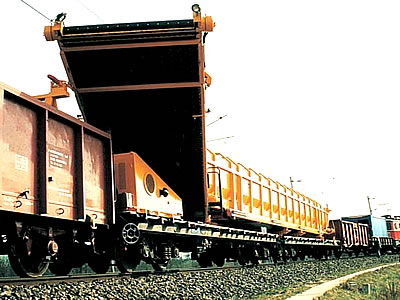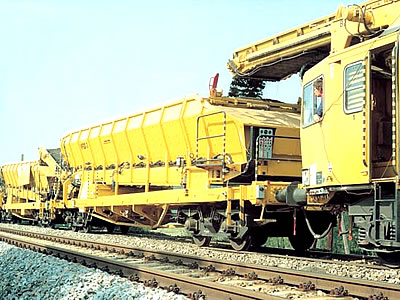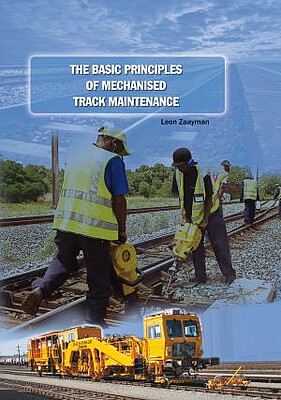Ballast management
The ballast needed for a functioning track network is an important capital asset. Enormous investment costs for substantial quantities of ballast make cost-efficient management of the raw material essential. Economical distribution of ballast over the complete network is a big source of potential savings. On one hand, many sections of track have far too much ballast in relation to the standard profile, which could be picked up and reused. On the other hand, the insertion of new ballast in areas lacking ballast requires additional expenditure. A uniform ballast bed also improves the durability of the track geometry, whereas irregular ballast increases the risk of buckling. Too much ballast may hinder proper drainage. Also track conversion from wood to concrete sleepers can generate a surplus of ballast. Conventional methods of ballast manipulation, i.e. loading, transporting, distributing, picking up and removal of excess ballast, require a lot of time, staff and resources. Economic management in this way is not possible.
Material Conveyor and Hopper Units (MFS units)
In several track operations, such as, for example, ballast cleaning, a considerable amount of spoil is accumulated. Depending on the severity of the pollution and spatial depth this can be up to 0.8 m³ per metre of track, and often even more. While in the past, the material was deposited at the side of the track formation, today the spoil must be transported to the disposal site. In many situations, such as in station areas, tunnels or cuttings, it is absolutely essential to evacuate the spoil.
In other cases, such as formation rehabilitation, large amounts of new material are necessary, which need to be correctly measured out to the machine.
Demands placed on a material loading system:
- Loading, conveying, storage and discharge processes are largely automated.
- Trouble-free adaptation to the respective worksite and operating conditions.
- Simple operation with minimum staff Costs.
- Independent energy supply.
- Positioning exclusively in the track under repair.
- Savings in site logistics result from the above mentioned points.
The flexible basic design of these machines enables them to be adapted to different operating conditions, both for loading the spoil as well as the supply of new material. MFS units are available with a capacity of up to 100 m³, with different numbers of axles and with slewable or rigid front conveyor belt.
MFS are open wagons of a standard vehicle design with an underbody conveyor in the hopper and a transfer conveyor belt on the end surface of the unit. The underbody conveyor ensures a continuous filling of the silos but allows the material to be conveyed from end to end. The transfer belt discharges the loose material into the next hopper or at a suitable place. It can be slewed 45 degrees to the left or right. Tip warning and tip protection prevent a tipping of the vehicle while unloading. A protected control desk with operating and control instruments for the conveyor belts is part of the standard design.
Any number of machines can be put together to form material trains. MFS units with rigid transfer conveyor belts serve as part of the conveyor line and/or as a storage unit. The discharge is carried out via an MFS unit in the train consisting of a slewing conveyor belt.
The machines are suitable for any kind of loose material. The conveyor belts are driven hydraulically and the energy for this is provided by a diesel engine.
Method of Work:
Today, many ballast bed cleaning machines which can supply new ballast are in use, such as the Plasser & Theurer RM 900 series or the RM 95-700. In conjunction with these machines the MFS units are used both for collecting spoil and for supplying new ballast. A typical use of such a machine combination is described below.
- The MFS units for spoil handling are propelled by the ballast cleaning machine, the units with the new ballast are towed.
- Spoil is passed over from the ballast cleaning machine to the first MFS unit.
- The material is passed on to the foremost unit.
- Continuous loading of the spoil train from the front to the back.
- When the front half of the material train is full, the MFS units are uncoupled and taken to the disposal site.
- The spoil is unloaded and wagons returned to the work site.
- In the meantime, the remaining RM units are loaded.
- Coupling on the emptied MFS units and tranship the material into the front half of the spoil train.
- After its re-loading the process will begin anew.
- The new ballast is fed from the MFS units behind the RM, where the discharge is carried out continuously from the back to the front.
In this way the cleaning machine can work without interruption. The number of MFS units used for the spoil depends amongst other factors on the amount of material to be expected, the distance to the discharging location and the working speed of the RM. The number of MFS units required for the supply of new ballast depends on the requirement calculated for the prevailing worksite situation.
MFS 40/MFSD 40/MFS 40/4-A:
Placing of ballast using MFS units:
The MFS type material conveyor and hopper units are well suited for placement of ballast:
- Fast loading of ballast material.
- Exact dosage and placement of the Ballast.
- Direct supply to ballast cleaning machines or other distributing machines.
- Short term storage of excavated ballast during track and switch renewal work.
The Austrian Federal Railways use MFS units for turnout conversions and thereby achieve significant time savings in the construction site work. Cleaned ballast from the adjacent track is put into the construction gaps and then consolidated. In addition, this method prevents the system that was usual in the past where lorries that brought ballast destroyed the surface of the formation protection layer.
But it is also possible to place ballast in the track with MFS units. For this the first unit is fitted with transfer conveyor belt and distribution equipment. By adding further MFS units to such a ballast train the capacity can easily be adjusted to the construction site Situation.
You can find suitable specialist literature to the topic here:
The Basic Principles of Mechanised Track Maintenance
This book is dedicated to the many people involved in the day to day planning and performance of track maintenance activities. Providing a practical approach to everyday challenges in mechanised track maintenance, it is not just intended as a theoretical approach to the track system.
Railways aim at transporting people and freight safely, rapidly, regularly, comfortably and on time from one place to another. This book is directed to track infrastructure departments contributing to the above objective by ensuring the track infrastructure’s reliability, availability, maintainability and safety – denoted by the acronym RAMS. Regular, effective and affordable track maintenance enable RAMS to be achieved.

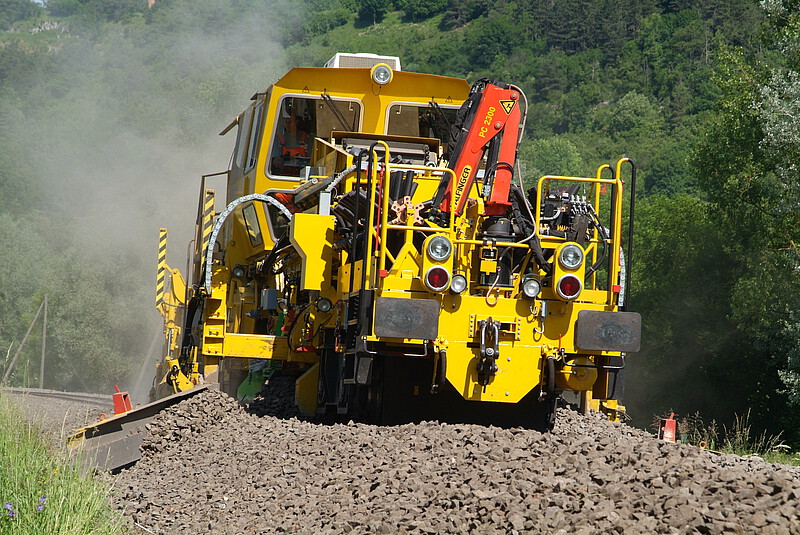
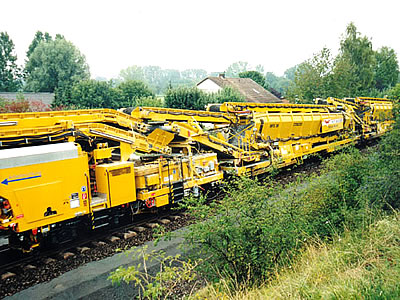
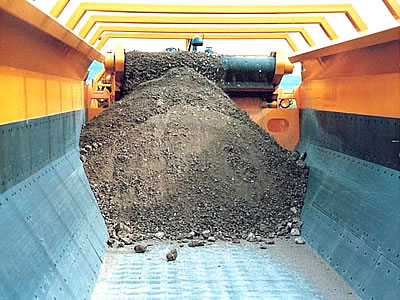
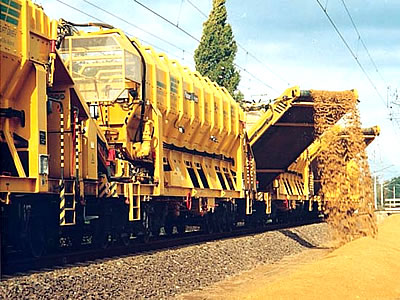
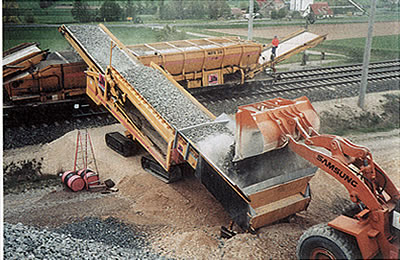
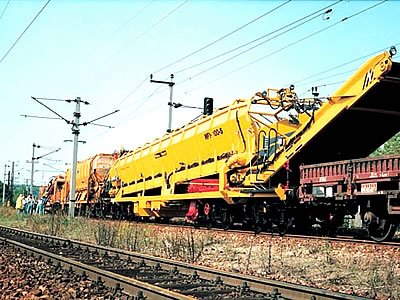
![Materialfoerder- und Siloeinheit [Translate to English:] Bild mit Genehmigung von Plasser&Theurer](/fileadmin/user_upload/03_Gleisbau_und_Instandhaltung/Schotterbearbeitung/material_foerder_und_siloeinheit_100_bild6a.jpg)
